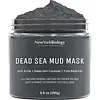What's inside
What's inside
 Key Ingredients
Key Ingredients

 Benefits
Benefits

 Concerns
Concerns

 Ingredients Side-by-side
Ingredients Side-by-side

Potato Starch Modified
Sea Silt
Skin ConditioningWater
Skin ConditioningZea Mays Starch
AbsorbentKaolin
AbrasiveSimmondsia Chinensis Seed Oil
EmollientGlycerin
HumectantAloe Barbadensis Leaf Juice
Skin ConditioningCetyl Alcohol
EmollientHelianthus Annuus Seed Oil
EmollientButyrospermum Parkii Butter
Skin ConditioningCarya Ovata Bark Extract
Skin ConditioningCalendula Officinalis Flower Oil
MaskingDimethicone
EmollientTrehalose
HumectantCaprylic/Capric Triglyceride
MaskingBeeswax
Emulsion StabilisingTocopherol
AntioxidantXanthan Gum
EmulsifyingAllantoin
Skin ConditioningSodium Hyaluronate
HumectantLavandula Angustifolia Oil
MaskingPotassium Sorbate
PreservativeSodium Benzoate
MaskingPotato Starch Modified, Sea Silt, Water, Zea Mays Starch, Kaolin, Simmondsia Chinensis Seed Oil, Glycerin, Aloe Barbadensis Leaf Juice, Cetyl Alcohol, Helianthus Annuus Seed Oil, Butyrospermum Parkii Butter, Carya Ovata Bark Extract, Calendula Officinalis Flower Oil, Dimethicone, Trehalose, Caprylic/Capric Triglyceride, Beeswax, Tocopherol, Xanthan Gum, Allantoin, Sodium Hyaluronate, Lavandula Angustifolia Oil, Potassium Sorbate, Sodium Benzoate
Water
Skin ConditioningBentonite
AbsorbentKaolin
AbrasivePropylene Glycol
HumectantMacrocystis Pyrifera Extract
Skin ConditioningSea Salt
AbrasiveLavandula Angustifolia Oil
MaskingCitrus Aurantium Bergamia Fruit Oil
MaskingTocopherol
AntioxidantCaprylic/Capric Triglyceride
MaskingMontmorillonite
AbsorbentMagnesium Aluminum Silicate
AbsorbentTitanium Dioxide
Cosmetic ColorantDisodium EDTA
Sodium Polyacrylate
AbsorbentDiazolidinyl Urea
PreservativeMethylparaben
PreservativePropylparaben
PreservativeMethylchloroisothiazolinone
PreservativeMethylisothiazolinone
PreservativeParfum
MaskingButylphenyl Methylpropional
PerfumingLinalool
PerfumingHydroxyisohexyl 3-Cyclohexene Carboxaldehyde
MaskingCI 42090
Cosmetic ColorantWater, Bentonite, Kaolin, Propylene Glycol, Macrocystis Pyrifera Extract, Sea Salt, Lavandula Angustifolia Oil, Citrus Aurantium Bergamia Fruit Oil, Tocopherol, Caprylic/Capric Triglyceride, Montmorillonite, Magnesium Aluminum Silicate, Titanium Dioxide, Disodium EDTA, Sodium Polyacrylate, Diazolidinyl Urea, Methylparaben, Propylparaben, Methylchloroisothiazolinone, Methylisothiazolinone, Parfum, Butylphenyl Methylpropional, Linalool, Hydroxyisohexyl 3-Cyclohexene Carboxaldehyde, CI 42090
 Reviews
Reviews

Ingredients Explained
These ingredients are found in both products.
Ingredients higher up in an ingredient list are typically present in a larger amount.
This ingredient is an emollient, solvent, and texture enhancer. It is considered a skin-softener by helping the skin prevent moisture loss.
It helps thicken a product's formula and makes it easier to spread by dissolving clumping compounds.
Caprylic Triglyceride is made by combining glycerin with coconut oil, forming a clear liquid.
While there is an assumption Caprylic Triglyceride can clog pores due to it being derived from coconut oil, there is no research supporting this.
Learn more about Caprylic/Capric TriglycerideKaolin is a clay. It is used for oil control and to help minimize pores. Like other clays, kaolin has the ability to absorb excess sebum or oil. This can help clean out pores and mattify the skin.
Some types of kaolin may have exfoliating properties. When water is added to kaolin, it becomes a paste with small abrasive particles.
Most kaolin is a white color, but may be pink/orange/red depending on where it comes from.
The name 'kaolin' comes from a Chinese village named 'Gaoling'. Kaolin clay comes from rocks rich in kaolinite. Kaolinite, the mineral, has a silicate layered structure. Kaolinite is formed from chemical weathering of aluminum siilicate minerals.
Besides skincare, kaolin is commonly used to make glossy paper, in ceramics, toothpaste, and as medicine to soothe stomach issues.
Learn more about KaolinLavandula Angustifolia Oil is more commonly known as lavender essential oil. It is considered a fragrancing ingredient.
Lavender imparts a famous scent. While the smell is lovely, this ingredient and may sensitize skin in topical products. This is because about 85% of the oil is made up of linalool and linalyl acetate.
When exposed to air, these two compounds become strong allergens. This ingredient exhibits cytotoxicity at low concentrations; amounts of 0.25% have been shown to damage skin cells.
A study from Japan found this ingredient caused lavender sensitivity after widespread exposure.
Lavender essential oil has some antimicrobial, antibacterial, and anti-inflammatory properties. However, the cons of this ingredient may outweight the pros.
More research is needed to confirm lavender essential oil's effects when used in aromatherapy.
Lavandula Angustifolia is known as the English Lavender and famous for creating purple fields in Provence, France.
Learn more about Lavandula Angustifolia OilTocopherol (also known as Vitamin E) is a common antioxidant used to help protect the skin from free-radicals and strengthen the skin barrier. It's also fat soluble - this means our skin is great at absorbing it.
Vitamin E also helps keep your natural skin lipids healthy. Your lipid skin barrier naturally consists of lipids, ceramides, and fatty acids. Vitamin E offers extra protection for your skin’s lipid barrier, keeping your skin healthy and nourished.
Another benefit is a bit of UV protection. Vitamin E helps reduce the damage caused by UVB rays. (It should not replace your sunscreen). Combining it with Vitamin C can decrease sunburned cells and hyperpigmentation after UV exposure.
You might have noticed Vitamin E + C often paired together. This is because it is great at stabilizing Vitamin C. Using the two together helps increase the effectiveness of both ingredients.
There are often claims that Vitamin E can reduce/prevent scarring, but these claims haven't been confirmed by scientific research.
Learn more about TocopherolWater. It's the most common cosmetic ingredient of all. You'll usually see it at the top of ingredient lists, meaning that it makes up the largest part of the product.
So why is it so popular? Water most often acts as a solvent - this means that it helps dissolve other ingredients into the formulation.
You'll also recognize water as that liquid we all need to stay alive. If you see this, drink a glass of water. Stay hydrated!
Learn more about Water